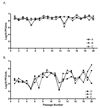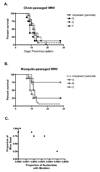The West Nile virus mutant spectrum is host-dependant and a determinant of mortality in mice - PubMed (original) (raw)
The West Nile virus mutant spectrum is host-dependant and a determinant of mortality in mice
Greta V S Jerzak et al. Virology. 2007.
Abstract
To define the impact of mosquitoes and birds on intrahost WNV population dynamics, the mutant spectra that arose as a result of 20 serial in vivo passages in Culex pipiens and young chickens were examined. Genetically homogeneous WNV was serially passaged 20 times in each host. Genetic diversity was greater in mosquito-passaged WNV compared to chicken-passaged WNV. Changes in the viral consensus sequence occurred in WNV passaged in mosquitoes earlier and more frequently than in chicken-passaged WNV. Analysis of synonymous and nonsynonymous variation suggested that purifying selection was relaxed during passage in mosquitoes. Mortality in mice was significantly negatively correlated with the size of the WNV mutant spectrum. These studies suggest that mosquitoes serve as sources for WNV genetic diversity, that birds are selective sieves, and that both the consensus sequence and the mutant spectrum contribute to WNV phenotype.
Figures
Figure 1.
Mean titer of WNV during sequential passage in mosquitoes (A) and chickens (B). Each of three independent lineages (designated A–F) per host type is shown.
Figure 2.
Host‐dependence of the WNV mutant spectrum. WNV derived from an infectious cDNA clone was passaged 20 times in either chickens or mosquitoes, and the mutant spectrum was characterized at passages 1, 5, 10, 15 and 20. Panels A and C: proportion of nucleotides sequenced that differed from the specimen‐specific consensus sequence in chicken (A) and mosquito (C) passaged WNV. Open symbols indicate values for each of three replicate lineages, designated G, W and R for chickens and A, B, and C for mosquitoes. Solid line indicates background error rate as determined by analysis of clone‐derived WNV, dotted line indicates homologous field‐derived observation (Jerzak, Bernard et al., 2005). Panels B and D: proportion of clones that differed from the specimen‐specific consensus sequence and chicken (B) and mosquito (D) passaged WNV. Open symbols, solid and dotted lines are as above.
Figure 3.
Survival of mice infected with (A) chicken‐ and (B) mosquito‐passed WNV. Groups of eight six‐week‐old female C3H mice were inoculated subcutaneously in the left rear footpad with 102.5 PFU of WNV and survival was monitored. Mock‐inoculated mice (not shown) remained healthy for the duration of the study. Results were obtained from two independent trials, and the survival curve for mice inoculated with the parental (unpassed) WNV is the combined data from both trials. Lineages are designated R, G and W for chick‐passaged and A, B, and C for mosquito‐passaged lineages. (C): percentage mortality at the study conclusion was significantly negatively correlated with overall genetic diversity in the inoculum.
Similar articles
- Nonconsensus West Nile virus genomes arising during mosquito infection suppress pathogenesis and modulate virus fitness in vivo.
Ebel GD, Fitzpatrick KA, Lim PY, Bennett CJ, Deardorff ER, Jerzak GV, Kramer LD, Zhou Y, Shi PY, Bernard KA. Ebel GD, et al. J Virol. 2011 Dec;85(23):12605-13. doi: 10.1128/JVI.05637-11. Epub 2011 Sep 21. J Virol. 2011. PMID: 21937657 Free PMC article. - Genetic diversity and purifying selection in West Nile virus populations are maintained during host switching.
Jerzak GV, Brown I, Shi PY, Kramer LD, Ebel GD. Jerzak GV, et al. Virology. 2008 May 10;374(2):256-60. doi: 10.1016/j.virol.2008.02.032. Epub 2008 Apr 18. Virology. 2008. PMID: 18395240 Free PMC article. - Noncoding Subgenomic Flavivirus RNA Is Processed by the Mosquito RNA Interference Machinery and Determines West Nile Virus Transmission by Culex pipiens Mosquitoes.
Göertz GP, Fros JJ, Miesen P, Vogels CBF, van der Bent ML, Geertsema C, Koenraadt CJM, van Rij RP, van Oers MM, Pijlman GP. Göertz GP, et al. J Virol. 2016 Oct 28;90(22):10145-10159. doi: 10.1128/JVI.00930-16. Print 2016 Nov 15. J Virol. 2016. PMID: 27581979 Free PMC article. - West Nile virus: the Indian scenario.
Paramasivan R, Mishra AC, Mourya DT. Paramasivan R, et al. Indian J Med Res. 2003 Sep;118:101-8. Indian J Med Res. 2003. PMID: 14700342 Review. - West Nile virus infections in Greece: an update.
Papa A. Papa A. Expert Rev Anti Infect Ther. 2012 Jul;10(7):743-50. doi: 10.1586/eri.12.59. Expert Rev Anti Infect Ther. 2012. PMID: 22943398 Review.
Cited by
- Assessment of the Risk of Severe Dengue Using Intrahost Viral Population in Dengue Virus Serotype 2 Patients via Machine Learning.
Hung SJ, Tsai HP, Wang YF, Ko WC, Wang JR, Huang SW. Hung SJ, et al. Front Cell Infect Microbiol. 2022 Feb 10;12:831281. doi: 10.3389/fcimb.2022.831281. eCollection 2022. Front Cell Infect Microbiol. 2022. PMID: 35223554 Free PMC article. - The number and genetic relatedness of transmitted/founder virus impact clinical outcome in vaginal R5 SHIVSF162P3N infection.
Tsai L, Tasovski I, Leda AR, Chin MP, Cheng-Mayer C. Tsai L, et al. Retrovirology. 2014 Mar 11;11:22. doi: 10.1186/1742-4690-11-22. Retrovirology. 2014. PMID: 24612462 Free PMC article. - Genomic approaches for understanding dengue: insights from the virus, vector, and host.
Sim S, Hibberd ML. Sim S, et al. Genome Biol. 2016 Mar 2;17:38. doi: 10.1186/s13059-016-0907-2. Genome Biol. 2016. PMID: 26931545 Free PMC article. Review. - West Nile virus adaptation to ixodid tick cells is associated with phenotypic trade-offs in primary hosts.
Ciota AT, Payne AF, Kramer LD. Ciota AT, et al. Virology. 2015 Aug;482:128-32. doi: 10.1016/j.virol.2015.03.033. Epub 2015 Apr 9. Virology. 2015. PMID: 25863877 Free PMC article. - The role of environmental factors on the evolution of phenotypic diversity in vesicular stomatitis virus populations.
Smith-Tsurkan SD, Herr RA, Khuder S, Wilke CO, Novella IS. Smith-Tsurkan SD, et al. J Gen Virol. 2013 Apr;94(Pt 4):860-868. doi: 10.1099/vir.0.048082-0. Epub 2012 Dec 12. J Gen Virol. 2013. PMID: 23239575 Free PMC article.
References
- Aaskov J, Buzacott K, Thu HM, Lowry K, Holmes EC. Long‐term transmission of defective RNA viruses in humans and Aedes mosquitoes. Science. 2006;311:236–238. - PubMed
- Beasley DW, Li L, Suderman MT, Barrett AD. Mouse neuroinvasive phenotype of West Nile virus strains varies depending upon virus genotype. Virology. 2002;296:17–23. - PubMed
- Davis CT, Ebel GD, Lanciotti RS, Brault AC, Guzman H, Siirin M, Lambert A, Parsons RE, Beasley DW, Novak RJ, Elizondo‐Quiroga D, Green EN, Young DS, Stark LM, Drebot MA, Artsob H, Tesh RB, Kramer LD, Barrett AD. Phylogenetic analysis of North American West Nile virus isolates, 2001–2004: evidence for the emergence of a dominant genotype. Virology. 2005;342:252–265. - PubMed
- Domingo E, Escarmis C, Martinez MA, Martinez‐Salas E, Mateu MG. Foot‐and‐mouth disease virus populations are quasispecies. Curr.Top.Microbiol.Immunol. 1992;176:33–47. - PubMed
Publication types
MeSH terms
Substances
Grants and funding
- N01AI25490/AI/NIAID NIH HHS/United States
- R21 AI055609/AI/NIAID NIH HHS/United States
- U54A17158/PHS HHS/United States
- R21 AI055609-02/AI/NIAID NIH HHS/United States
- U54 AI057158/AI/NIAID NIH HHS/United States
- N01-AI25490/AI/NIAID NIH HHS/United States
- N01 AI25490/AI/NIAID NIH HHS/United States
- AI055609/AI/NIAID NIH HHS/United States
LinkOut - more resources
Full Text Sources
Other Literature Sources
Medical


